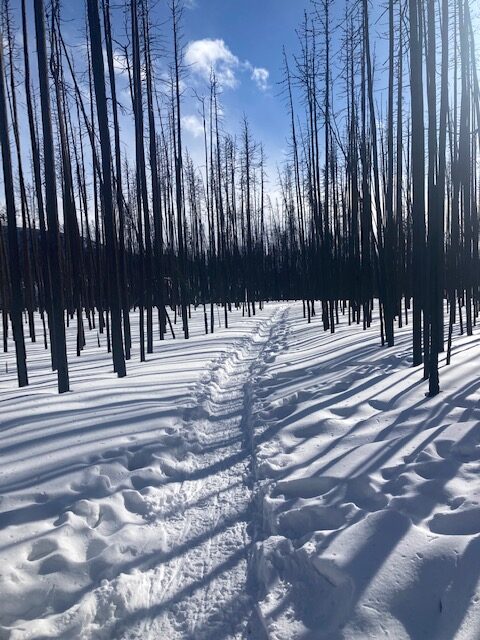
Black against white. An azure blue sky above. And silent, oh so silent.
When I first moved out west, I became familiar with alpine forests. Always attracted to wilderness and national parks, I started weekend sojourns to Yosemite National Park. The park teemed with activity during summers, with thousands of tourists.
But my favorite time of year?
The winter. Snow would blanket the meadows, trees and glorious peaks. Everything seemed hushed, and I got to have it all to myself a lot of the time. It was during one of these wintertime visits, that I first learned how to cross-country ski.
A park ranger friend of mine worked at Badger Pass, leading snowshoe walks. Looking for things to do while visiting one weekend, I rented cross-country skis. The Glacier Point Road was groomed for skiing, but what I loved most was breaking trail through the woods along the roads. Following the blue diamonds posted on the trees seemed like my own personal adventure. One trail in particular piqued my curiosity.
Ghost Forest Loop.
I’d never heard the term. What was a ghost forest?
As I set off into the woods, I soon understood the term. Blackened, scorched trunks surrounded me — remnants of a wildfire from years past. To some, it might seem ugly, unsightly.
I was reminded of my first experience this past weekend while exploring the western side of Rocky Mountain National Park this weekend. We brought our snowshoes and trekked up the North Inlet Trail. And trudged through plenty of ghost forest — all that was left from the massive East Troublesome Fire from last October.
Though I knew the statistics – more than 192,000 acres burned — Colorado’s biggest wildfire.
But seeing ridge upon ridge of burnt trees brought the reality home of how much forest had burned. I also hadn’t realized just how close the fire had come to the Kawunechee Visitor Center — trees scorched right up to the parking lot.
But on this day with blue skies and fresh snow, there was mystery in walking through the corpses of trees. Scorched trunk one after the other and a weird phenomenon I’d never seen. Trees bowed into arches. Did the fire burn so hot that the pitch make the trunk malleable? I tried to find out through the internet, but still don’t know.
Something about walking through this tree graveyard reminded me of the cycle of life. That this ghost forest would come alive with new life in the not too distant future. That wildflowers would be blooming this summer. I stood next to an aspen, singed but seemingly not destroyed.
“You’ll be sending up your suckers all around you now!” I proclaimed. Aspens are one of the first trees to propagate after wildfire. With the competition gone, they send out sucker trees from their roots to take advantage of the sun and moisture. Those small flowers and aspen will bring in elk and deer to graze their tender shoots.
I’m old enough to remember the wildfire of 1988 in Yellowstone National Park.
Newspapers proclaimed, “Yellowstone is gone!”
But if you’ve been to Yellowstone recently, and visited the area of that fire, you’ll scarcely remember that fire, as it is teeming with life. Trees, shrubs, flowers, wildlife.
So as we snowshoed through the ghost forest, I was reminded, it is an end, but also a beginning. Nature always finds a way to heal.

